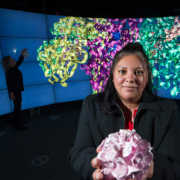The Age reporter, Liam meets Jamie, Sabrina and Erica
Science relies on light. What about people who can’t see?
Working out how to harness light has brought extraordinary advances.
Microscopes can now see the innards of a cell. Space-based telescopes can see millions of years back in time. The pictures they beam back to Earth are beautiful.
To those with limited vision, this beauty is ungraspable. They are often isolated from the wonders of science – and from the rest of the community.
“It’s enormously frustrating, oh my god,” says artist Dr Erica Tandori, who is legally blind. “Science, it has this sense of wonder. Why should we be excluded, be denied that wonder?”
That frustration is at the heart of a new artistic collaboration that is trying to make some of science’s most significant advances tangible – and at the same time find employment for people with low-vision at the nation’s universities, places they are often excluded from.
So Dr Tandori made some of science’s most beautiful images tactile.
There are detailed possum and rat retinas done in putty. 3D-printed models of cells. A battle-scene tableau as a disease fights against immune system defenders. A model of the gastro virus, rotavirus, done in spaghetti and beans.
At a half-day event at Monash University’s Clayton campus, people with low-vision will be taken through the science by experts as they explore Dr Tandori’s models with their hands.
Sabrina Constantin delicately cups one of the models in her palms. It is pink, and glitters in the light. It looks like a sea anemone on acid. Sabrina, who has low vision, smiles. “It’s the texture. What I cannot see, I can feel, I can imagine.”
It’s a dendritic cell, one of the sentinels of the immune system, built out of paper mache. “Can you recognise it?”, Dr Tandori asks Professor Rossjohn, who laughs.
He seems a little bemused, seeing his life’s work turned into disco balls. “Yeah,” he shakes his head, “I don’t have an artistic bone in my body.”
The Sensory Scientific Exhibition and Discovery Day will be held May 31 at Monash University’s Clayton Campus (19 Ancora Imparo Way) from 9.30am to 1pm. The event is free. A free shuttle bus will run to the campus from the city.
Original article by Liam Mannix (The Age)
Photo credit: Jason South




